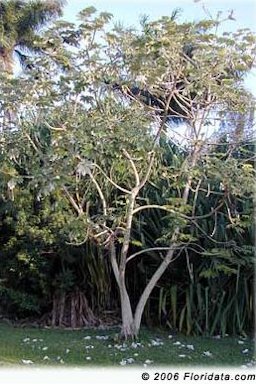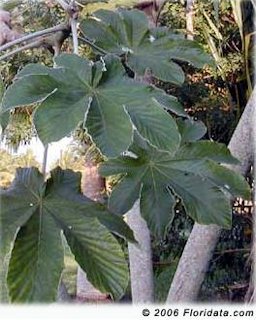From Floridata
by
Linda Conway Deuver, and Steve Christman
Cecropia peltata
Common
Names: trumpet tree, snakewood, congo pump, wild pawpaw,
pop-a-gun
Botanical
Family: Moraceae, the mulberry Family
Description
Trumpet
tree is an awkwardly branched, open-crowned tree with alternate leaves
about a foot (30 cm) wide clustered at tips of inwardly curving stems.
It can grow to 70 ft (21 m) tall, but most trees are much smaller. The
leaves have 7-11 palmate lobes and are borne on long petioles which
attach near the center of the leaf. Leaves are rough-textured and dark
green above and felty white underneath. The smooth gray bark on young
trees is ringed with leaf scars. The flowers are small inconspicuous
yellow catkins. They are followed by numerous small seeds embedded in 3
in (7.5 cm) long soft-fleshed fruiting stems. Prop roots sometimes
develop at the base of the tree. Cecropia
peltata is often confused with C. palmata, which
has leaves divided almost to the base (as opposed to a third of the way
in) and longer fruits. C.
peltata may also be mistaken for Didymopanax morototoni,
an unrelated lookalike tree.

Trumpet Tree
Location
Cecropia
peltata
is native to Central America, northern South America, and the
Caribbean, and it has naturalized in parts of Africa. This is an
early-succession species adapted to grow rapidly in disturbed areas. It
is therefore most common in secondary woods and along forest edges.
Culture
These
are fast growing, short-lived trees. Young specimens can put on 2-3 in
(5-8 cm) diameter per year. They need fertile soil to grow well and
dislike competition from lawn grasses.
Light:
Trumpet tree does best in full sun.
Moisture: These
trees grow best on well drained soils with ample moisture.
Hardiness: USDA
Zones 10 - 11. This is a very frost sensitive tree that throws a
dramatic tantrum and flings big brown leaves all around when it gets
chilled.
Propagation: Trumpet
tree can be propagated from seed, but the seeds germinate slowly. In
the wild, the seeds are dispersed by bats and birds.
Usage
Cecropias
are widely planted for tropical landscape effects. The young buds may
be eaten as a cooked vegetable. The corrosive and astringent latex is
used against warts, calluses, herpes, ulcers, dysentery, and venereal
diseases. The leaves of both Cecropia
peltata and C.
palmata
are used in herbal medicine under the name "embauba leaf." A tea made
from the leaves is widely employed as a cure for asthma and thought to
be useful in treating a wide variety of other ailments including liver
disease, cardiovascular problems, Parkinson's disease, and snakebite.
It also is used to ease childbirth and menstrual complaints. The
trumpet tree's main trunk is solid and composed of a soft, weak,
brittle, lightweight wood. It is combined with cement to make
insulation board and made into excelsior, matchsticks, crates, toys,
partitions, and paper pulp. The wood ignites readily from friction and
makes good tinder. A latex rubber is made from the milky sap and the
inner bark yields a coarse fiber. The leaves are sometimes used as
sandpaper. The hollow stems have been fashioned into musical
instruments, fishing floats, life preservers, water troughs, gutters,
and bottle "corks." The dead leaves dry dark mahogany brown above and
white beneath, and curl into interesting sculptural forms which can be
used in dried arrangements.

Trumpet tree foliage
Features
In
addition to providing quick (though patchy) shade and tropical
atmosphere, the trumpet tree makes a fine ecological conversation
piece. In the tree's native habitat biting ants live in the hollow
stems. In a mutually beneficial relationship, the small but fierce ants
clean the tree of debris and protect it from leaf-cutter ants and other
herbivores, while the tree provides the ants with shelter and food in
the form of special food-bodies produced along the undersides of the
leaf stems.
Warning
Many
regions lack the ants that live in wild Latin American trumpet trees,
but it is wise to be cautious around these trees until you are certain
that the ones you are dealing with are ant-free.
|
|

